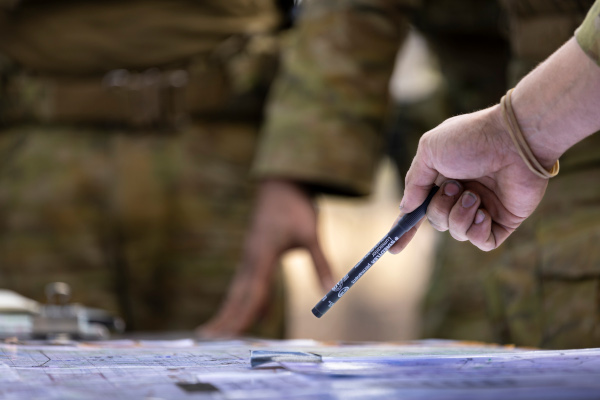
After two decades of small wars in the Middle East, and with a looming threat of large-scale combat operations (LSCO) in the Indo-Pacific, the Australian Army is re-learning painful lessons on how to fight at scale against a peer adversary. Talisman Sabre (Ex TS) 2023 was therefore a timely activity which saw an Australian division comprising three combat brigades (two real, one simulated) manoeuvre and fight under a US corps which also controlled another (simulated) US division.
Compared to previous Ex TS which saw a single Australian combat brigade under a static Australian divisional headquarters, this was an increase in operational complexity. It was also notable for another reason – the investment of planning time and resources in the divisional deception plan.
The 1st Australian Division Joint Fires and Effects Coordination Centre (JFECC) used a detailed deception plan to reduce the risk to 3 and 7 Brigades as they conducted river crossings on the divisional main axis. To achieve this, the divisional reserve (a simulated 9 Brigade) was made to appear to be the main effort on a different axis. Via technical and cognitive means, this 9 Brigade force was amplified to the enemy commander to appear as a reinforced brigade advancing to secure river crossings on an axis to isolate Charters Towers.
At a key moment of risk for 3 and 7 Brigades, the deception plan triggered the enemy to prematurely launch their armoured reserve in the wrong direction so that US I Corps attack aviation could destroy it in detail. In this way, a deception plan which layered lethal and non-lethal, cognitive, and technical effects, created favourable conditions for the true divisional main effort. This small component of Ex TS 2023 demonstrates that detailed deception planning can be valuable for the Australian Army to de-risk decisive phases of LSCO.

The Australian Army does not have a strong tradition of operational deception planning. Throughout our history, it is hard to find examples of theatre or operational deception plans on the scale of those executed by our allies in the 1944 Normandy landings or the 1991 liberation of Kuwait. Our deception doctrine is almost non-existent, and we have no formal deception planners’ course or unit of deception experts.
Yet, the Australian Army is the perfect beneficiary of these types of activities at the divisional level. We are small (our brigades are approximately half the size of their NATO equivalents) and in the face of larger, better-equipped adversaries we should embrace deliberate deception in the way that the Armed Forces of Ukraine (AFU) dislocated larger Russian forces for the Kherson offensive.
Faced with a stronger adversary the AFU identified that even large armies quickly suffer limitations in ISR, manoeuvre, and fires. If effective deception is employed, then scant resources will be misapplied in the wrong places and create opportunities for decisive manoeuvre elsewhere. The AFU has built upon the old Soviet deception methods of Maskirovka modernised for the age of loitering munitions and ubiquitous tactical UAVs.[1]
Part of the problem for the Australian Army is that we often mischaracterise what deception is. We immediately imagine short-term tactical actions that simply achieve surprise. These are tactically valuable, and all planners should seek to be unpredictable to the enemy. However, creating surprise is not deception, it’s just good planning. Many of our biggest limitations are operational, and at that level, deception requires time, resourcing, and discipline – which uncomfortably comes at the expense of other parts of the plan. Luckily our closest allies have excellent doctrine for deception, and this can provide Australia with a proven foundation for developing our deception planning.
The US Army's approach to deception at the operational level is laid out in Field Manual 3-13-4 Army Support to Military Deception. This FM defines deception as “actions executed to deliberately mislead adversary military, para-military or violent extremist organisation decision makers, thereby causing the adversary to take specific actions (or inactions) that will contribute to the accomplishment of the friendly mission”. The key part of this definition is that the deception must result in a tangible outcome which enables friendly mission success.
A historical example of this is the deception plan incorporated into Operation Desert Storm during the 1991 liberation of Kuwait. A detailed and deliberate US deception plan not only convinced Iraqi commanders that the assault would be directly into Kuwait but crucially resulted in Iraqi forces reducing their dispositions along the Iraq-Saudi Arabian border and exposing their western flank. It was this re-posture rather than just the Iraqi expectation of the direction of advance which made the coalition envelopment so decisive. It created changes to the Iraqi dispositions and force laydown optimised for the success of the coalition plan.

The most important part of deception planning is to identify the deception goal. What do we as planners want the adversary to do? We may want them to move forces where they cannot oppose our operations, thus creating favourable force ratios for our real plan. We may want them to disregard our offensive as not being genuine and thus buy time to establish a lodgement.
To achieve the goal, we must understand how the adversary makes decisions. Most militaries follow a process WWII deception planners called ‘See-Think-Do’. First, the adversary ISR system will ‘See’ something. This could be from a cavalry patrol, aerial observation, or Electronic Warfare collection. Having ‘Seen’ something, the adversary will interpret this information and ‘Think’ what it means. Reports of howitzers and logistic build-up may result in an intelligence assessment that this is a brigade artillery maintenance area, indicative of that brigade’s intended axis of advance. Finally, the adversary will ‘Do’ something with that information. For example, they may unmask their own artillery to destroy the target.
When planning a deception, this process is reversed into ‘Do-Think-See’. Deception planners first ask what we want the adversary to ‘Do’. If it is unmasking their guns so we can destroy them, the next question is what must they ‘Think’ to do this? Perhaps providing a juicy target of opportunity may prompt the guns to be unmasked. Finally, the deception planners identify what the adversary is to ‘See’ – howitzers and logistic build-up (all using expendable decoys). By following this reverse planning process, the deception planners never lose sight of the goal of the deception – the desired enemy action.
US Joint doctrine identifies five deception tactics that can be layered into a deception plan. These are diversions, feints, demonstrations, ruses, and displays.[2] These are the building blocks of a deception plan and understanding the difference between them and what they seek to achieve is key to effective deception planning. A single deception tactic on its own is unlikely to achieve a deception.
Many readers would be familiar with Operation Mincemeat during WWII. The dropping of a dead body with fake secret documents into enemy hands is a compelling example of a ‘ruse’. What is not well known is that Mincemeat was one of hundreds of deception actions that collectively contributed to deceiving Nazi Germany as to Allied intent for the invasion of Europe.
Examples included false radio traffic in Scotland (a ‘diversion’), inflatable tanks in southeast England (a ‘display’), deliberate operational security breaches by Defence Attaches in neutral countries (a ‘ruse’), and Royal Air Force and Special Air Service raids into Calais before the Normandy landings (a ‘feint’). Planning, synchronising, and measuring the effect of so many components requires significant staff effort. Headquarters (HQ) 1st Australian Division is lucky that deception planning is championed by the chain of command. However, more can be done to reinforce this approach across all Australian Army planning for LSCO.

A key step forward would be a deception staff planners’ course and the requirement that all headquarters have a certain number of staff officers qualified. The inclusion of deception planning as a teaching objective for the Australian Command and Staff Course and the Joint Operations Planning Course would ensure that key staff officers in brigade and divisional HQs were aware of the benefits of deception. There should also be an investment in the technology and workforce to execute deception plans. This would likely draw on reservists who could generate platoon-size elements to support deception with decoys of both the physical and technical kind as well as analysts equipped and authorised to use social media and cyberspace for deception. Such units would need to be equipped to both improvise decoys and use the rapidly deployable vehicle decoys being employed currently in Ukraine.
Finally, our collective training exercises need opportunities to test our use of deception, and for the adversary to try and deceive us. These steps would require modest investments in personnel and equipment but ensure that in LSCO Australian forces were more survivable and more intellectually agile in prevailing against peer adversaries. The best deception begins before the fighting starts. That time is now.
End Notes
[1] Maskirovka means ‘little theatre’ in Russian. It was the Soviet term for the large-scale and sophisticated deception plans employed by the Red Army with great success in WW2. For more information see Soviet Military Deception in the Second World War by David Glantz, published 1989 by Frank Cass & Co.
[2] JP 3-13-4 MILDEC defines the deception tactics on page I-9 as follows; Feint: “an offensive action involving contact with the adversary conducted for the purpose of deceiving the adversary as to the location and/or time of the actual main offensive action”; Demonstration: “a show of force where a decision is not sought and no contact with the adversary is intended. A demonstration’s intent is to cause the adversary to select a COA favorable to US goals”; Ruse: “a cunning trick designed to deceive the adversary to obtain friendly advantage. It is characterized by deliberately exposing false or confusing information for collection and interpretation by the adversary”; Display: “the simulation, disguising, and/or portrayal of friendly objects, units, or capabilities in the projection of the MILDEC story”.









